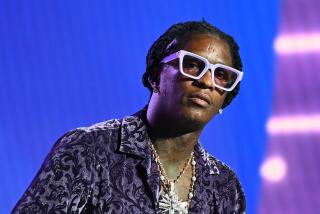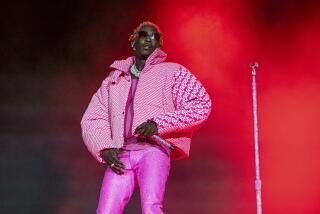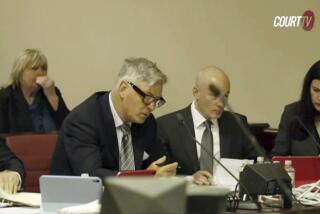Jury Selection in Simpson Trial Ends After 11 Weeks : Courts: Both sides accept racially mixed group of alternates. Judge can now focus on legal, evidence issues.
- Share via
A lengthy string of setbacks, sidetracks and postponements came to an end in the O.J. Simpson murder trial Thursday as both sides accepted a racially mixed panel of alternate jurors, concluding a grueling jury selection process that has dragged on since late September.
The final round of jury selection in the Simpson case unfolded in a tense, quiet courtroom with the two sides taking turns exercising peremptory challenges--those used to remove a panelist without stating the reason. When the process concluded, the nine-woman, three-man alternate panel included seven blacks, four whites and one Latino.
They will be pressed into service if any of the 12 regular jurors are removed, a possibility that already has surfaced amid allegations of improper behavior by one or more of the Simpson jurors.
Simpson smiled broadly Thursday when the selection process ended. His two principal attorneys, Johnnie L. Cochran Jr. and Robert L. Shapiro, strode together to the lectern and Shapiro announced: “On behalf of O.J. Simpson, we accept the jury.”
Jury selection in the Simpson case has been under way since Sept. 26, when the first panelists filled out an exhaustive questionnaire probing their feelings about the case and searching for any biases that might make them unfit to serve.
With jurors and alternates now in place, the judge and attorneys can at last begin focusing on legal issues and evidence in the case. On Monday, they will take up a defense effort to block the introduction of any evidence of marital discord between Simpson and his ex-wife, Nicole Brown Simpson.
The slashed and stabbed bodies of Nicole Simpson and Ronald Lyle Goldman were discovered June 13, shortly after midnight. Simpson has been charged with those murders; he has pleaded not guilty and has vigorously proclaimed his innocence.
The painstaking questioning that jury candidates have undergone reflects the high stakes that both sides place on finding an impartial panel to weigh the evidence against the former football superstar. More than 100 candidates were dismissed during the selection process, and at least one of those selected for the alternate panel has expressed deep reservations about being chosen for the case.
The reluctant alternate juror has repeatedly asked to be let go, saying that she had served on a previous jury and found the experience trying. She displayed no emotion as the panel was sworn in.
Some of her colleagues on the panel seemed more enthusiastic about the prospect of serving, and all survived detailed questioning intended to weed out those who could not be impartial. The group includes a legal secretary, a receptionist, a real estate appraiser and a county worker, among others. Most of the alternates completed high school but did not graduate from college. Only one panelist reported no knowledge of the freeway pursuit that culminated in Simpson’s arrest June 17.
Those who were not selected during Thursday’s final round were excused after being effusively thanked by Superior Court Judge Lance A. Ito.
“I am personally grateful to have had the opportunity to meet each and every one of you,” said Ito, who has guided the jury selection process for nearly 11 weeks, halting it occasionally to deal with the unexpected developments that have come to characterize the Simpson case. “You got to participate in something that was important and significant.”
As one of the excused alternate jurors left, he flashed a thumbs-up sign at Simpson, who did not appear to notice. That man, a 58-year-old labor relations specialist from Pico-Union, had earlier told the attorneys that he thought he would make a good juror because of his experience in labor issues. He also described himself as the victim of domestic violence--one of three male jury candidates who related experiences involving women striking their spouses. Simpson has made similar assertions in describing his relationship with Nicole Simpson.
The painstaking process of selecting a jury came at the end of about two hours of strategic maneuvering by both sides Thursday.
As the jury candidates watched silently, Simpson huddled with his lawyers, debating the composition of the panel each time that it was their turn to exercise a challenge or accept the group of alternates.
The prosecution went first, excusing a 43-year-old black woman from South-Central. At first, it appeared that the process could end quickly; Simpson’s lawyers announced that they would accept the panel as it stood. But after prosecutors challenged two more panelists, Simpson’s team joined the exchange. At the session’s end, prosecutors had challenged six blacks and one Latino. Simpson’s lawyers excused three Latinos, two whites, one Asian American and one black.
The panel’s composition has been closely watched in a case in which racial issues lurk just beneath the surface. Simpson, a black man, is charged with the murders of two whites.
Peremptory challenges may not be used to remove prospective jurors because of their race or sex, but Ito did not find that the challenges used by either side were being employed in a discriminatory manner.
The 12 alternate jurors will take their places alongside 12 regular jurors, but the composition of the two panels could begin shifting even before a word of evidence is presented in the case. Responding to the allegations of improper behavior leveled against at least one of the regular jurors, Ito has convened a series of closed-door fact-finding sessions to determine whether anyone should be removed from the panel.
Neither Ito nor the attorneys would say what allegations are being investigated, and the opposing lawyers could not even agree on what to call the hearings. Defense lawyers, who are thrilled with the composition of the Simpson jury, downplayed the seriousness of the allegations, saying they were merely hearsay and speculation; Deputy Dist. Atty. Marcia Clark accused her counterparts of misstating the thrust of the hearings and said the allegations, if true, probably involved misconduct.
Although Clark said transcripts of the hearings would support her description, Ito turned down a request by Kelli L. Sager, a lawyer representing news organizations, to have those transcripts released.
Ito said he would consider releasing the transcripts once he has completed his inquiry into issues surrounding the two jurors, but he would not release anything until then. It is not clear whom Ito intends to question to get to the bottom of the matter, but Arnelle Simpson, O.J. Simpson’s daughter, was in court Thursday, and a source close to the case said she was on hand to testify if asked.
The two sides are scheduled to return to court today, when they will begin to tackle a host of legal issues that have backed up while jury selection was under way. One item on today’s agenda is a defense motion to force Deputy Dist. Atty. Christopher Darden off the government team.
Simpson’s lawyers have argued that Darden should not be allowed to prosecute Simpson, in part because he was the lead government attorney probing the actions of Simpson’s friend Al Cowlings, who was arrested June 17 on suspicion of aiding a fugitive. Simpson’s lawyers charged that a grand jury investigation into Cowlings actually was a ruse to develop evidence against Simpson and have sought to keep prosecutors from using any evidence gathered in the Cowlings investigation against Simpson.
Among the documents unsealed Thursday by Ito was a ruling by another Superior Court judge who concluded that the grand jury was not being misused and a statement by the grand jury forewoman explaining some of the issues that the panel investigated. That statement makes clear that grand jurors were interested in Cowlings’ role not only on the day of the pursuit but also during the previous afternoon, when he helped dupe reporters into believing that Simpson was at home in Brentwood.
“After the funeral, Cowlings and Simpson exchanged clothing,” the statement said. “Cowlings practiced walking like Simpson. Cowlings covered his head with his jacket, entered Simpson’s limousine and returned to Simpson’s residence in Brentwood. This ruse caused the media and the police to believe that Simpson had returned to his Brentwood home.”
Instead, Simpson, aided by an off-duty LAPD sergeant, slipped away to the Encino home of friend Robert Kardashian. The next day, after Simpson failed to turn himself in to the police on schedule, he and Cowlings fled from that house, leaving moments before police arrived to take Simpson into custody.
After they were spotted on Interstate 5 in Orange County, the two men headed back to Simpson’s home in Brentwood with a phalanx of police cars trailing slowly behind them. Simpson then surrendered as a nationwide television audience watched.
* THE SPIN: Closed misconduct hearing is a victory for jurors’ rights. B1



